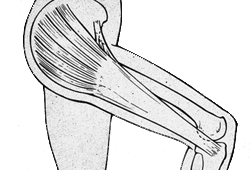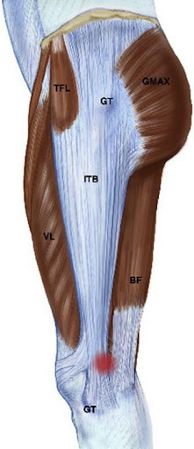Резюме
Определение
ანამნეზი და გასინჯვა
ძირითადი დიაგნოსტიკური ფაქტორები
- history of athleticism
- sharp or burning pain superior to the lateral joint line
- positive Noble test
- positive Ober test
- positive modified Thomas test
სხვა დიაგნოსტიკური ფაქტორები
- reduced hip abductor muscle strength
- genu varum (bow leg), hindfoot and forefoot varum, and pes cavus (high arch)
- prominent lateral femoral epicondyle
- swelling, local edema, or crepitations
რისკფაქტორები
- athlete
- high weekly mileage
- interval training
- muscular weakness of knee extensors, knee flexors, and hip abductors
- lack of running experience
- use of worn-out running shoes
- downhill running, or running on a cambered or slippery surface
- female sex
- preexisting iliotibial band tightness
- leg-length discrepancies
- step width and strain rate
- knee varus in male runners
- muscular weakness in hip external rotator muscles in male runners
- excessive hip internal rotation in male runners
დიაგნოსტიკური კვლევები
1-ად შესაკვეთი გამოკვლევები
- clinical diagnosis
გასათვალისწინებელი კვლევები
- x-ray of knee
- ultrasound of knee
- MRI of knee
მკურნალობის ალგორითმი
pain and inflammation
resolved pain and inflammation
refractory to conservative treatment
კონტრიბუტორები
ავტორები
Bob Baker, PT, PhD, MBA, OCS

Rehabilitation Services Manager
NorthBay Healthcare
Fairfield
CA
გაფრთხილება:
BB is an author of articles cited in this topic.
Jenson C. Mak, PhD, FRACP, FAFRM, FACP, MBBS

Rehabilitation Fellow
University of Sydney
Sydney
Australia
გაფრთხილება:
JCM declares that he has no competing interests.
Michael Fredericson, MD, FACSM

Professor of Orthopaedic Surgery
Stanford Medical Center
Stanford University
Stanford
CA
გაფრთხილება:
MF is an author of several articles cited in this topic.
რეცენზენტები
Robert Werner, MD
Professor
Chief of Physical Medicine and Rehabilitation
Ann Arbor VA Medical Center
Ann Arbor
MI
გაფრთხილება:
RW has been reimbursed by the University of Michigan for attending several conferences and has been paid an honorarium for speaking at the American Association of Neuromuscular and Electrodiagnostic Medicine national meeting. RW has been paid by the National Institute for Occupational Safety and Health, the American Dental Association, and SmartHealth as a consultant and has received grant funding from the UAW/GM Health and Safety Board (over US$1 million).
რეცენზენტების განცხადებები
BMJ Best Practice-ის თემების განახლება სხვადასხვა პერიოდულობით ხდება მტკიცებულებებისა და რეკომენდაციების განვითარების შესაბამისად. ქვემოთ ჩამოთვლილმა რეცენზენტებმა თემის არსებობის მანძილზე კონტენტს ერთხელ მაინც გადახედეს.
გაფრთხილება
რეცენზენტების აფილიაციები და გაფრთხილებები მოცემულია გადახედვის მომენტისთვის.
წყაროები
ძირითადი სტატიები
Fredericson M, Weir A. Practical management of iliotibial band friction syndrome in runners. Clin J Sport Med. 2006 May;16(3):261-8. აბსტრაქტი
გამოყენებული სტატიები
ამ თემაში მოხსენიებული წყაროების სრული სია ხელმისაწვდომია მომხმარებლებისთვის, რომლებსაც აქვთ წვდომა BMJ Best Practice-ის ყველა ნაწილზე.

დიფერენციული დიაგნოზები
- Biceps femoris tendinopathy
- Degenerative joint disease
- Lateral collateral ligament (LCL) sprain
მეტი დიფერენციული დიაგნოზებიგაიდლაინები
- Practical management of iliotibial band friction syndrome in runners
მეტი გაიდლაინებიVideos
Knee exam
მეტი ვიდეოებიშედით სისტემაში ან გამოიწერეთ BMJ Best Practice
ამ მასალის გამოყენება ექვემდებარება ჩვენს განცხადებას
